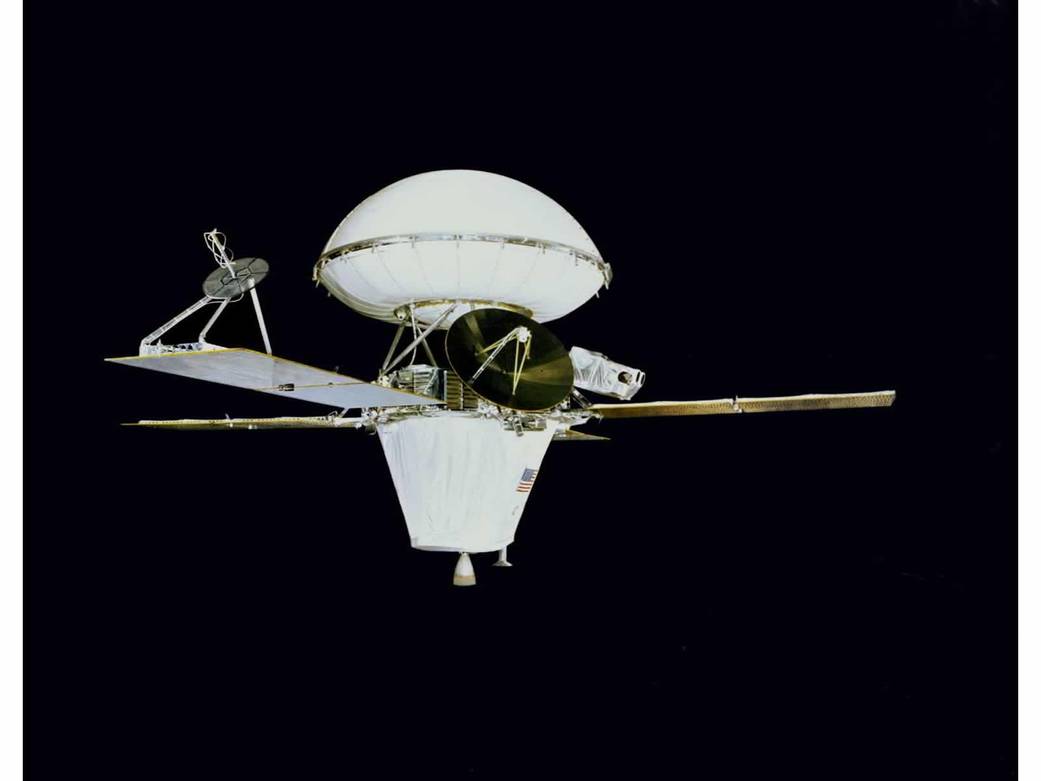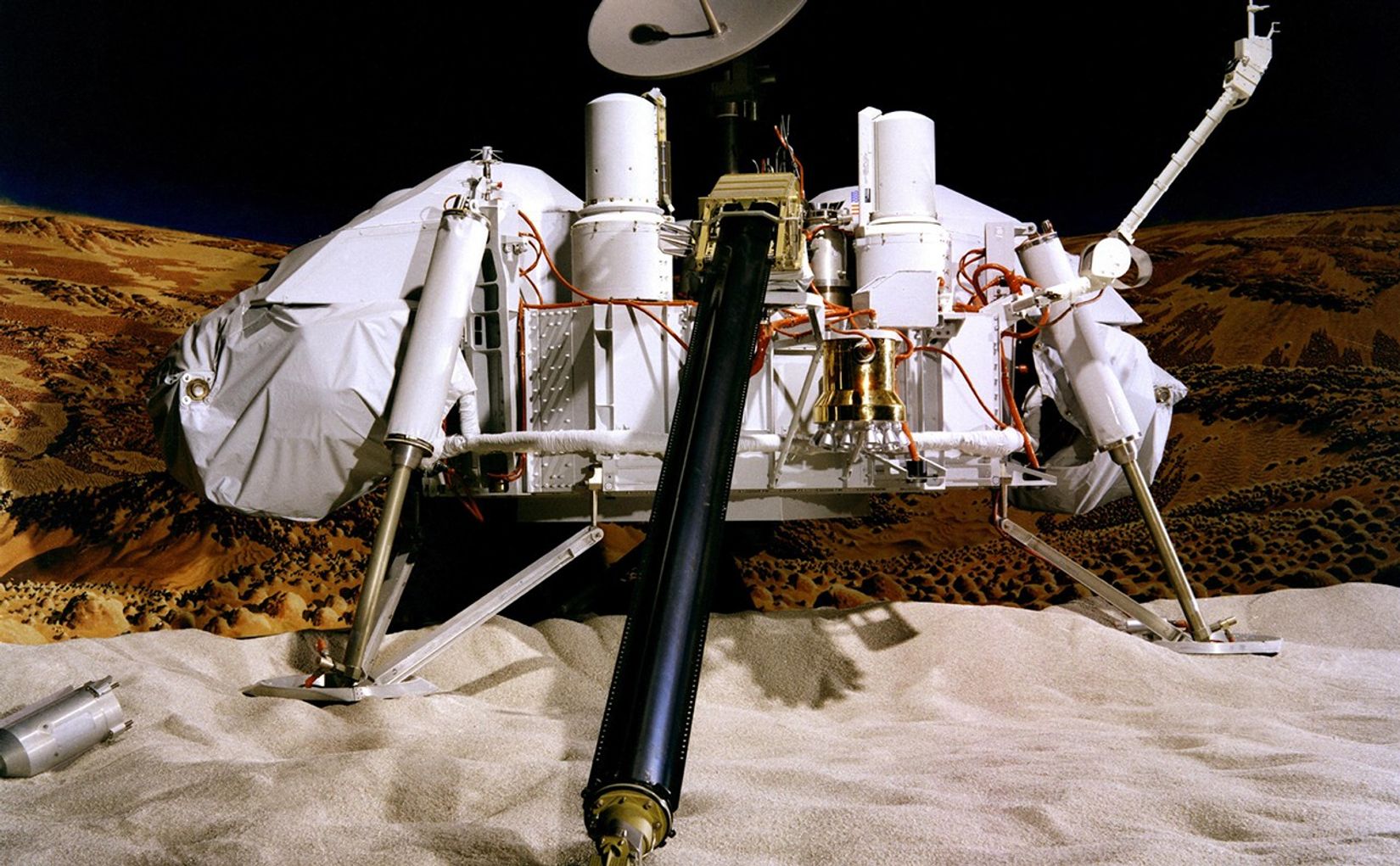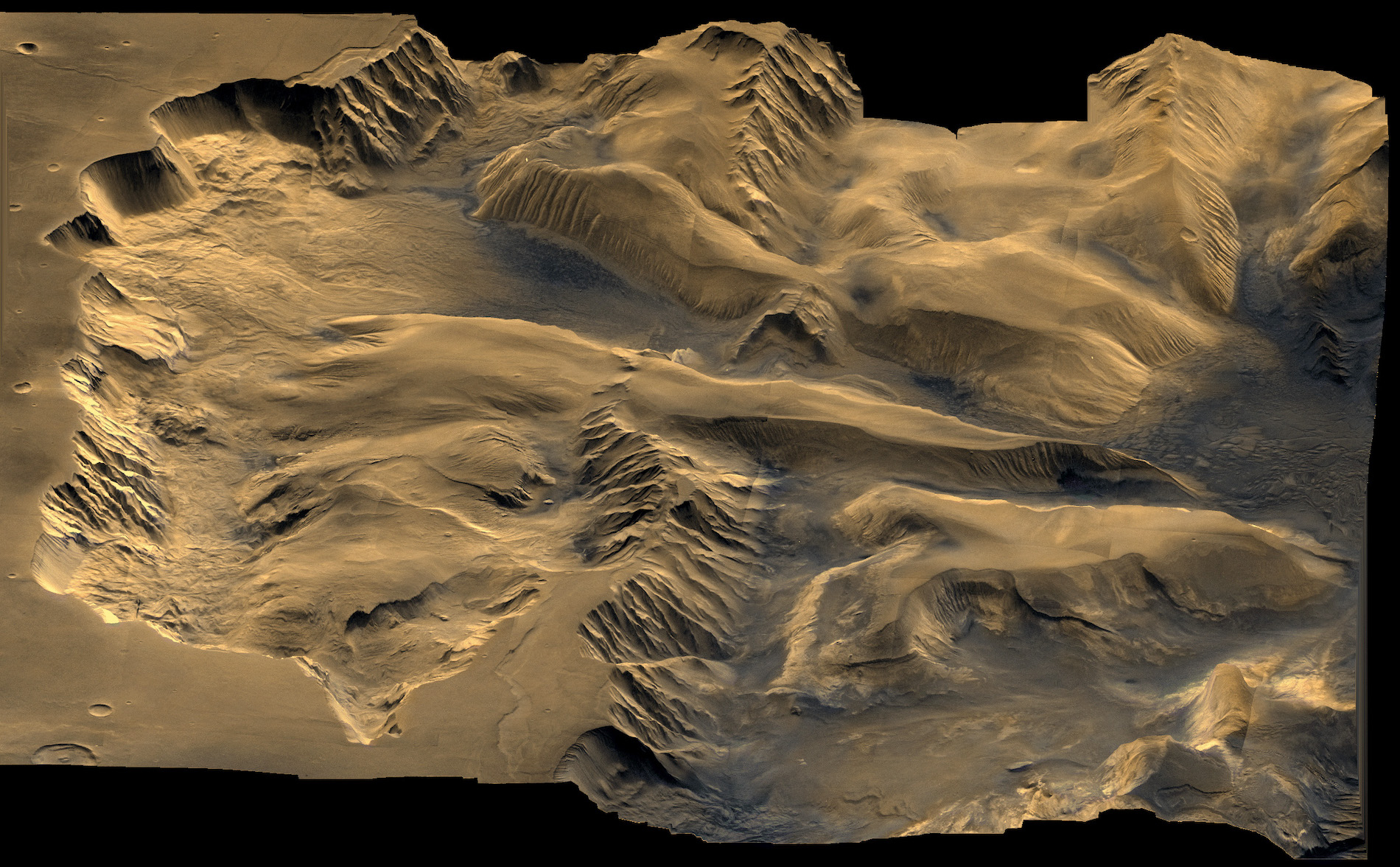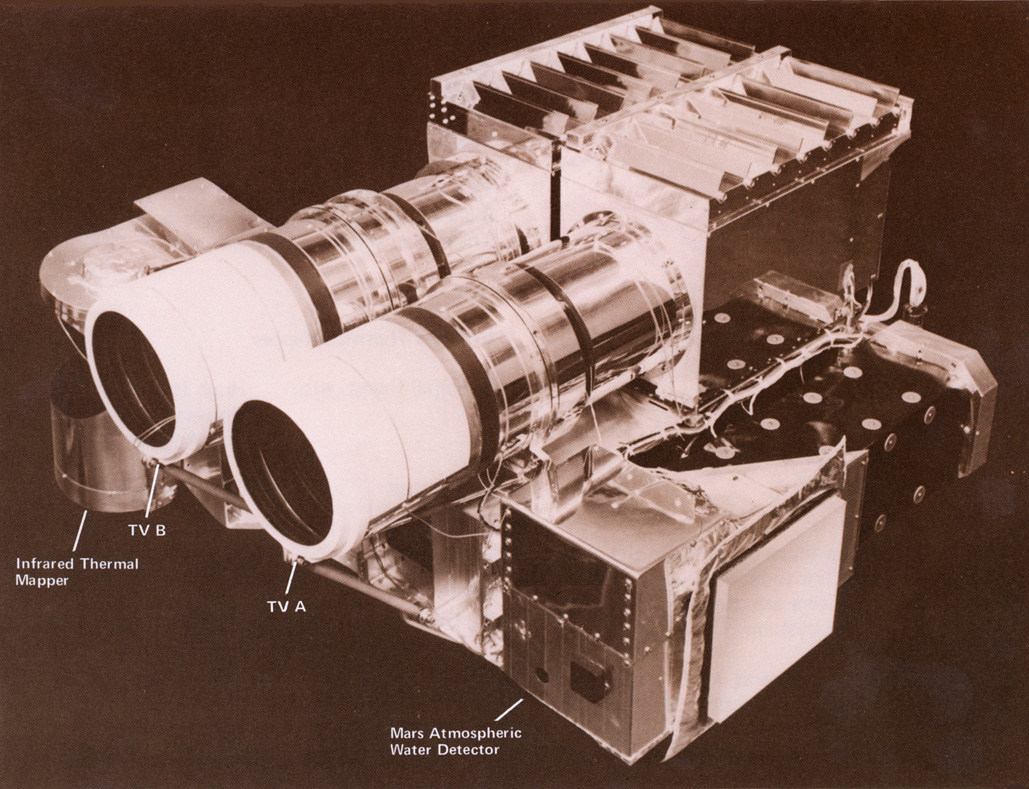Spacecraft and Science
NASA's Viking Mission to Mars was composed of two spacecraft, Viking 1 and Viking 2, each consisting of an orbiter and a lander - orbiters for imaging and scientific operations from orbit, and landers deployed instruments on the surface. The primary mission objectives were to obtain high-resolution images of the Martian surface, characterize the structure and composition of the atmosphere and surface, and search for evidence of life.
Viking Orbiters
The primary objectives of the Viking orbiters were to transport the landers to Mars, perform reconnaissance to locate and certify landing sites, act as communications relays for the landers, and to perform their own scientific investigations.
The Orbiters imaged the entire surface of Mars at a resolution of about 164 yards to 330 yards (150 to 300 meters), and selected areas a tabout 26 feet (8 meters). The Viking 2 Orbiter was powered down on July 25, 1978 after 706 orbits, and the Viking 1 Orbiter on Aug. 17, 1980, after over 1,400 orbits.

Orbiters Tech Specs
| Size | Octagon in shape and approximately 8.2 feet (2.5 meters) across (based on the earlier Mariner 9 spacecraft) overall height was 10.79 feet (3.29 meters) from the lander attachment points on the bottom to the launch vehicle attachment points on top. The eight faces of the ring-like structure were 1.5 feet (.4572 meters) high and were alternately 4.58 and 1.67 feet (1.397 and 0.508 meters) wide. |
| Launch Mass | 5,132.36 pounds (,2328 kilograms), of which 3,185.68 pounds (1445 kilograms) were propellant and attitude control gas. |
| Power | The power was provided by eight 1.57 x 1.23 meter solar panels, two on each wing. Four solar panel wings extended from the axis of the orbiter. The solar panels were made up of a total of 34,800 solar cells and produced 620 watts of power at Mars. Power was also stored in 2 nickel-cadmium 30-amp-hr batteries. |
| Propulsion | Propulsion was furnished by a bipropellant (monomethyl hydrazine and nitrogen tetroxide) liquid-fueled rocket engine which could be gimballed up to 9 degrees. The engine was capable of 1323 N thrust, translating to a delta-V of 1480 m/s. |
| Communications | Communications were accomplished through a 20-W S-band (2.3 GHz) transmitter and 2 20-W TWTA's. An X-band (8.4 GHz) downlink was also added specifically for radio science and to conduct communications experiments. Uplink was via S-band (2.1 GHz). A 2-axis steerable high-gain parabolic dish antenna with a diameter of nearly 5 feet (approximately 1.5 meters) was attached at one edge of the orbiter base, and a fixed low-gain antenna extended from the top of the bus. Two tape recorders were each capable of storing 1280 Mbits. A 381 MHz relay radio was also available. |
Orbiter Science Instruments
The orbiters’ scientific instruments were used for conducting imaging, atmospheric water vapor, and infrared thermal mapping.
Visual Imaging Subsystem
Viking Orbiter 1 visual imaging subsystem (VIS) consisted of twin high-resolution, slow-scan television framing cameras mounted on the scan platform of each orbiter with the optical axes offset by 1.38 degrees. Each of the two identical cameras on each orbiter had mechanical shutters; a 475-mm focal length telescope; a 37-mm diameter vidicon, the central section of which was scanned in a raster format of 1056 lines by 1182 samples. The two cameras were completely redundant, each with its own control, electronics, and power systems.
The VIS had four primary functions: to aid in the selection of landing sites that were both safe and scientifically interesting, to observe large-scale features of the landing sites for correlation with lander data from the surface, to observe and map the planet for subsequent study of the geologic features of the planet, and to investigate the atmosphere of Mars. Operation of this experiment was terminated on Aug. 7, 1980. The Viking 1 Orbiter camera returned approximately 34,200 images.
VIS Tech Specs (each camera)
| Size | 8.58 x 8.58 x 37.0 inches (21.8 x 21.8 x 94.0 centimeters) including their housing |
| Mass | Approximately 88.2 pounds (40 kilograms) |
| Camera Specs | 475-mm focal length telescope; a 37-mm diameter vidicon, the central section of which was scanned in a raster format of 1056 lines by 1182 samples. |
| Field of View | Each field of view was 1.54 deg x 1.69 degrees with each picture element (pixel) subtending 25 microradians. This translates to an image area on the surface of roughly 40 x 44 kilometers from an altitude of 1500 kilometers. |
Infrared Thermal Mapper (IRTM)
The purpose of the IRTM experiment was to measure the temperatures of the atmosphere and areas on the surface of Mars. The amount of sunlight reflected by the planet was also measured. The IRTM was a multichannel radiometer mounted on the orbiter's scan platform. Four small telescopes, each with seven infrared detectors, were aimed parallel to the visual imaging optical axis, and made observations every 1.12 seconds. The instrument was capable of measuring differences of 1 Celsius throughout a temperature range of -130 deg Celsius to +57 deg Celsius. The field of view was circular, 5 milliradians in diameter. Operation of this experiment was terminated on Aug. 7, 1980.
Mars Atmospheric Water Detector (MAWD)
The MAWD used an infrared grating spectrometer mounted on the orbiter scan platform that was boresighted with the television cameras and the Infrared Thermal Mapper. The instrument measured solar infrared radiation reflected from the surface through the atmosphere to the spacecraft. Spectral intervals were selected coincident with the wavelength of water-vapor absorption lines in the 1.4-micrometer band. The quantity of water vapor along the line of sight was measured from 1 to 100 micrometers of precipitable water with an accuracy of 5%or better. The instantaneous field of view of the instrument was 2 x 17 milliradians, and a stepping mirror rotated the line of sight through 15 positions to provide a roughly rectangular field of view of 17 x 31 milliradians. Operation of this experiment was terminated on Aug. 7, 1980.
Orbiter Radio Science
There are four distinct sets of Viking radio science data, three using orbiter data and one primarily using lander data with calibrations from orbiter data. The orbiter tracking data, obtained from the two-way orbiter-Earth S-band and X-band radio links, consist of Doppler frequencies and time-of-flight range measurements. These determined the position and motion of the orbiters, and can be used to study the Mars gravitational field, the plasma in interplanetary space, and the structure of the solar corona. The occultation data were obtained from these same radio links by analog recording of the signal when a spacecraft was passing into or out of occultation with Mars. The data can be used to produce altitude profiles of the temperature, density, and pressure of the atmosphere (including the ionosphere) and to measure the radius of the planet using a large number of surface points. The surface-properties aspect of this investigation utilized the UHF (381 MHz) signal on which the landers transmitted data to the orbiters. At the beginning or end of a data transmission session, when the orbiter was near the lander's horizon, the strength of the received signal was recorded as a function of time. These signal "fading patterns," resulting from interaction of the radio waves with the Martian surface, contain information about the physical properties of the surface near the landers. The lander tracking data from the two-way direct lander-earth S-band links permit determination of the location of the landers and studies of the motion of the planet. Operation of this experiment was terminated on Aug. 7, 1980.
Viking Landers
The Viking Landers transmitted images of the surface, took surface samples and analyzed them for composition and signs of life, studied atmospheric composition and meteorology, and deployed seismometers. The Viking 2 Lander ended communications on April 11, 1980, and the Viking 1 Lander on Nov. 13, 1982, after transmitting over 1,400 images of the two sites.
Besides taking photographs and collecting other science data on the Martian surface, the two Viking landers conducted three biology experiments designed to look for possible signs of life. These experiments discovered unexpected and enigmatic chemical activity in the Martian soil, but provided no clear evidence for the presence of living microorganisms in soil near the landing sites.

Lander Tech Specs
| Mass | 2.2 pounds (657 kilograms) |
| Base | Six-sided aluminum base with alternate 3.2 feet and 1.8 feet (1.09 meters and .56 meters) long sides, supported on three extended legs attached to the shorter sides. |
| Leg Footpads | Leg footpads formed the vertices of an equilateral triangle with 7.25 feet (2.21 meters) sides when viewed from above, with the long sides of the base forming a straight line with the two adjoining footpads. |
| Power | Two radioisotope thermal generator (RTG) units containing plutonium 238 were affixed to opposite sides of the lander base and covered by wind screens. |
| Propulsion | Monopropellant hydrazine (N2H4) rocket with 12 nozzles arranged in four clusters of three provided 32 N thrust, giving a delta-V of 180 meters per second. 85 kilograms of propellant at launch |
| Communications | 20 W S-band transmitter and two 20 W TWTA's. 2-axis steerable high-gain parabolic antenna An omnidirectional low-gain S-band antenna also extends from the base. Both these antennas allowed for communication directly with the Earth. UHF (381 MHz) antenna provided a one-way relay to the orbiter using a 30 W relay radio. |
Lander Science Instruments
The lander carried instruments to achieve the primary scientific objectives of the lander mission: to study the biology, chemical composition (organic and inorganic), meteorology, seismology, magnetic properties, appearance, and physical properties of the Martian surface and atmosphere. The scientific payload had a total mass of approximately 200 pounds (91 kilograms).
Tech Specs
| Cameras | Two 360-degree cylindrical scan cameras were mounted near one long side of the base. From the center of this side extended the sampler arm, with a collector head, temperature sensor, and magnet on the end. |
| Meteorology Boom | A meteorology boom, holding temperature, wind direction, and wind velocity sensors extended out and up from the top of one of the lander legs. |
| Seismometer | A seismometer, magnet and camera test targets, and magnifying mirror was mounted opposite the cameras, near the high-gain antenna. |
| Environmental Sensors | An interior environmentally controlled compartment held the biology experiment and the gas chromatograph mass spectrometer. |
| Spectrometer | The X-ray fluorescence spectrometer was also mounted within the structure. |
| Sensors | A pressure sensor was attached under the lander body. |
Science Highlights

The results from the Viking experiments gave our most complete view of Mars. Volcanoes, lava plains, immense canyons, cratered areas, wind-formed features, and evidence of surface water are apparent in the orbiter images. The planet appeared to be divisible into two main regions -
northern low plains and southern cratered highlands. Superimposed on these regions are the Tharsis and Elysium bulges, which are high-standing volcanic areas, and Valles Marineris, a system of giant canyons near the equator.
The surface material at both landing sites can best be characterized as iron-rich clay. Measured temperatures at the landing sites ranged from minus 189.67 to minus 9.67 degrees Fahrenheit (150 to 250 degrees Kelvin), with a variation over a given day of minus 396.67 to minus 369.67 degrees Fahrenheit (35 to 50 degrees Kelvin). Seasonal dust storms, pressure changes, and transport of atmospheric gasses between the polar caps were observed. The biology experiment produced no definitive evidence of life at either landing site.





























